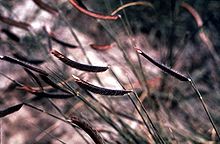Bouteloua gracilis
| Blue grama | |
|---|---|

| |
| Scientific classification | |
| Kingdom: | Plantae |
| Clade: | Tracheophytes |
| Clade: | Angiosperms |
| Clade: | Monocots |
| Clade: | Commelinids |
| Order: | Poales |
| Family: | Poaceae |
| Genus: | Bouteloua |
| Species: | B. gracilis
|
| Binomial name | |
| Bouteloua gracilis | |
Bouteloua gracilis, the blue grama, is a long-lived, warm-season (
It is most commonly found from
Blue grama accounts for most of the net
Description



Blue grama has green to greyish leaves less than 3 mm (0.1 in) wide and 1 to 10 in (25 to 250 mm) long. The overall height of the plant is 6 to 12 in (15 to 30 cm) at maturity.[7]
The flowering stems (
The roots generally grow 12 to 18 in (30 to 46 cm) outwards, and 3 to 6.5 ft (0.9 to 2.0 m) deep.[7]
Blue grama is readily established from
Established plants are
Distribution
Blue grama has the widest distribution of all grama grasses. It will grow on most soil types, and readily adapts to local conditions. It can be found as far north as Alberta, and as far south as Mexico. It is present in most of the Midwestern United States, extending east to Missouri and Texas, and as far west as Southern California. It has been introduced to some eastern states, as well as South America.[12]
Horticulture and agriculture
Blue grama is valued as forage, and is the most valuable grama. It is an ideal range grass in the southwest. It will survive heavy grazing and extreme drought, and is quite palatable to livestock.[12] Grazing of blue grama rangelands might also prevent invasion of undesirable weedy plants.[13]
Blue grama is grown by the
Blue grama has a large genome relative to other grama grasses.[14] It can be diploid or tetraploid.[15]
Among the
Ecology
Blue grama is the dominant species of the US shortgrass steppe ecoregion.[19][20] Populations of blue grama across the great plains are genetically differentiated (even at small spatial scales) and show functional trait variance connected to climate.[21][22][15] Blue grama from more arid grasslands are also characterized by greater phenotypic plasticity.[21]
It is a larval host to the
References
- ^ NatureServe (2023). "Bouteloua gracilis Blue Grama". NatureServe Explorer. Arlington, Virginia: NatureServe. Retrieved 28 April 2023.
- ^ a b c USDA, NRCS (n.d.). "Bouteloua gracilis". The PLANTS Database (plants.usda.gov). Greensboro, North Carolina: National Plant Data Team.
- ^ "Bouteloua gracilis". International Plant Names Index (IPNI). Royal Botanic Gardens, Kew; Harvard University Herbaria & Libraries; Australian National Botanic Gardens.
- ^ "Bouteloua gracilis". County-level distribution map from the North American Plant Atlas (NAPA). Biota of North America Program (BONAP). 2014. Retrieved July 13, 2018.
- ^ "Bouteloua gracilis". State-level distribution map from the North American Plant Atlas (NAPA). Biota of North America Program (BONAP). 2014. Retrieved July 13, 2018.
- Montana University Extension Service. Archived from the originalon June 10, 2010.
- ^ a b c d e f Anderson, Michelle D. (2003). "Bouteloua gracilis". Fire Effects Information System (FEIS). US Department of Agriculture (USDA), Forest Service (USFS), Rocky Mountain Research Station, Fire Sciences Laboratory. Retrieved August 24, 2016.
- ^ a b Sun, Bi-xing; Phillips, Sylvia M. "Bouteloua gracilis". Flora of China. Vol. 22 – via eFloras.org, Missouri Botanical Garden, St. Louis, MO & Harvard University Herbaria, Cambridge, MA.
- ^ a b Hilty, John (2020). "Blue Grama (Bouteloua gracilis)". Illinois Wildflowers.
- ^ Sun, Bi-xing; Phillips, Sylvia M. "Bouteloua". Flora of China. Vol. 22 – via eFloras.org, Missouri Botanical Garden, St. Louis, MO & Harvard University Herbaria, Cambridge, MA.
- ^ Chayka, Katy; Dziuk, Peter (2016). "Bouteloua gracilis (Blue Grama)". Minnesota Wildflowers.
- ^ a b Gould, Frank W. (1951). Grasses of Southwestern United States. Tucson: University of Arizona. p. 146.
{{cite book}}:|work=ignored (help) - S2CID 90458063.
- .
- ^ S2CID 18031688.
- ^ Stevenson, Matilda Coxe (1915). "Ethnobotany of the Zuni Indians". SI-BAE Annual Report #30. p. 83.
- S2CID 21852804.
- ^ Elmore, Francis H. (1944). Ethnobotany of the Navajo. Santa Fe, NM: School of American Research. p. 25.
- )
- .
- ^ PMID 32176814.
- S2CID 44199283.
- ^ The Xerces Society (2016), Gardening for Butterflies: How You Can Attract and Protect Beautiful, Beneficial Insects, Timber Press.

